Comprehensive Stakeholder Analysis Report: Allerton High School
VerifiedAdded on 2020/06/04
|7
|1577
|63
Report
AI Summary
This report provides a detailed stakeholder analysis, focusing on the context of Allerton High School. It begins by defining two main categories of stakeholders in a business organization and then applies these concepts to the educational environment, specifically identifying four key stakeholders of Allerton High School: school board members, teachers, parents, and administrators, and their respective relationships with the school. The report further examines the factors influencing stakeholder power and involvement in the school's mission statement. Additionally, the report explores the objectives and purposes of different types of organizations, including private sector and non-profit entities, providing a comprehensive overview of stakeholder dynamics within various organizational structures. The report references a variety of academic sources to support its findings.

Summative Project
(Part 1)
(Part 1)
Paraphrase This Document
Need a fresh take? Get an instant paraphrase of this document with our AI Paraphraser
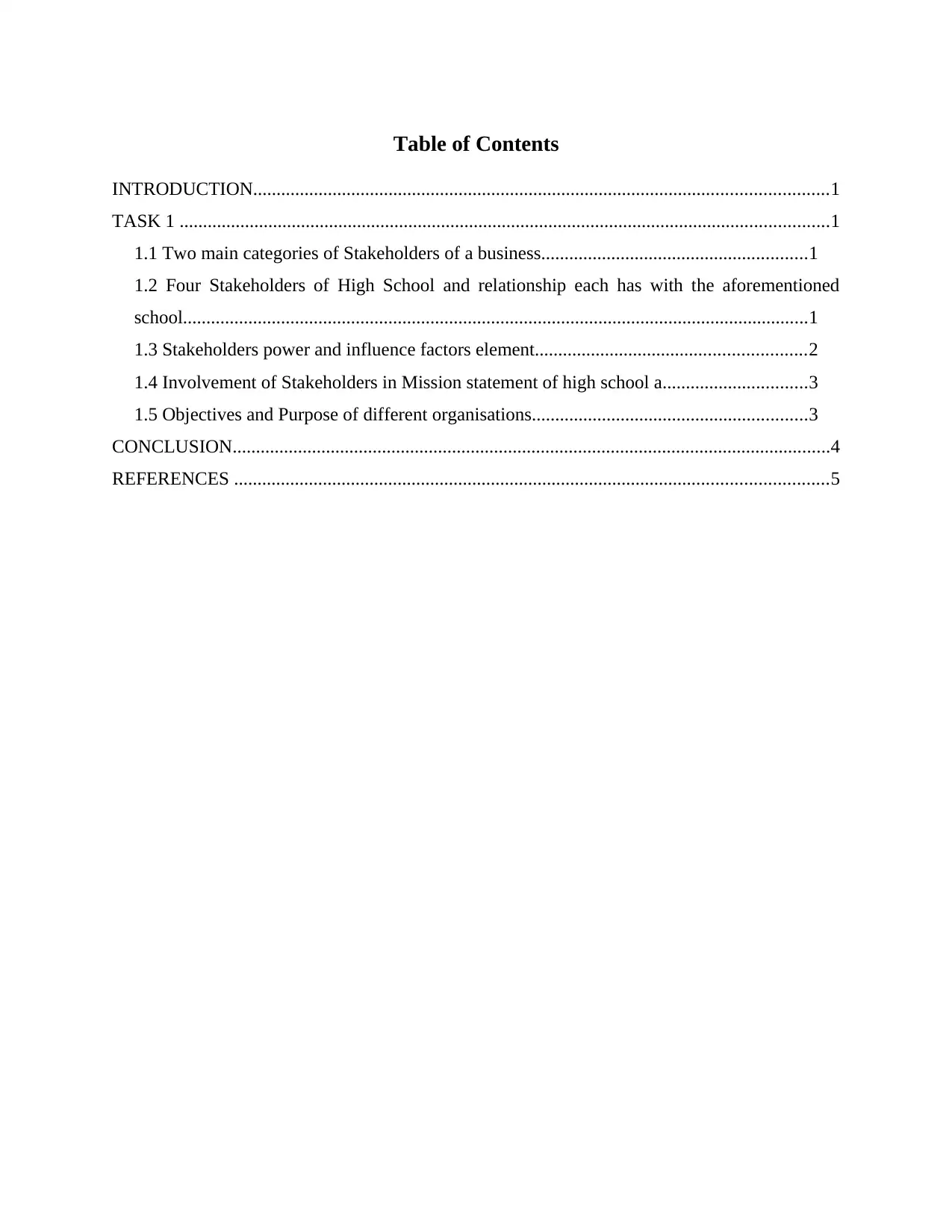
Table of Contents
INTRODUCTION...........................................................................................................................1
TASK 1 ...........................................................................................................................................1
1.1 Two main categories of Stakeholders of a business.........................................................1
1.2 Four Stakeholders of High School and relationship each has with the aforementioned
school......................................................................................................................................1
1.3 Stakeholders power and influence factors element..........................................................2
1.4 Involvement of Stakeholders in Mission statement of high school a...............................3
1.5 Objectives and Purpose of different organisations...........................................................3
CONCLUSION................................................................................................................................4
REFERENCES ...............................................................................................................................5
INTRODUCTION...........................................................................................................................1
TASK 1 ...........................................................................................................................................1
1.1 Two main categories of Stakeholders of a business.........................................................1
1.2 Four Stakeholders of High School and relationship each has with the aforementioned
school......................................................................................................................................1
1.3 Stakeholders power and influence factors element..........................................................2
1.4 Involvement of Stakeholders in Mission statement of high school a...............................3
1.5 Objectives and Purpose of different organisations...........................................................3
CONCLUSION................................................................................................................................4
REFERENCES ...............................................................................................................................5
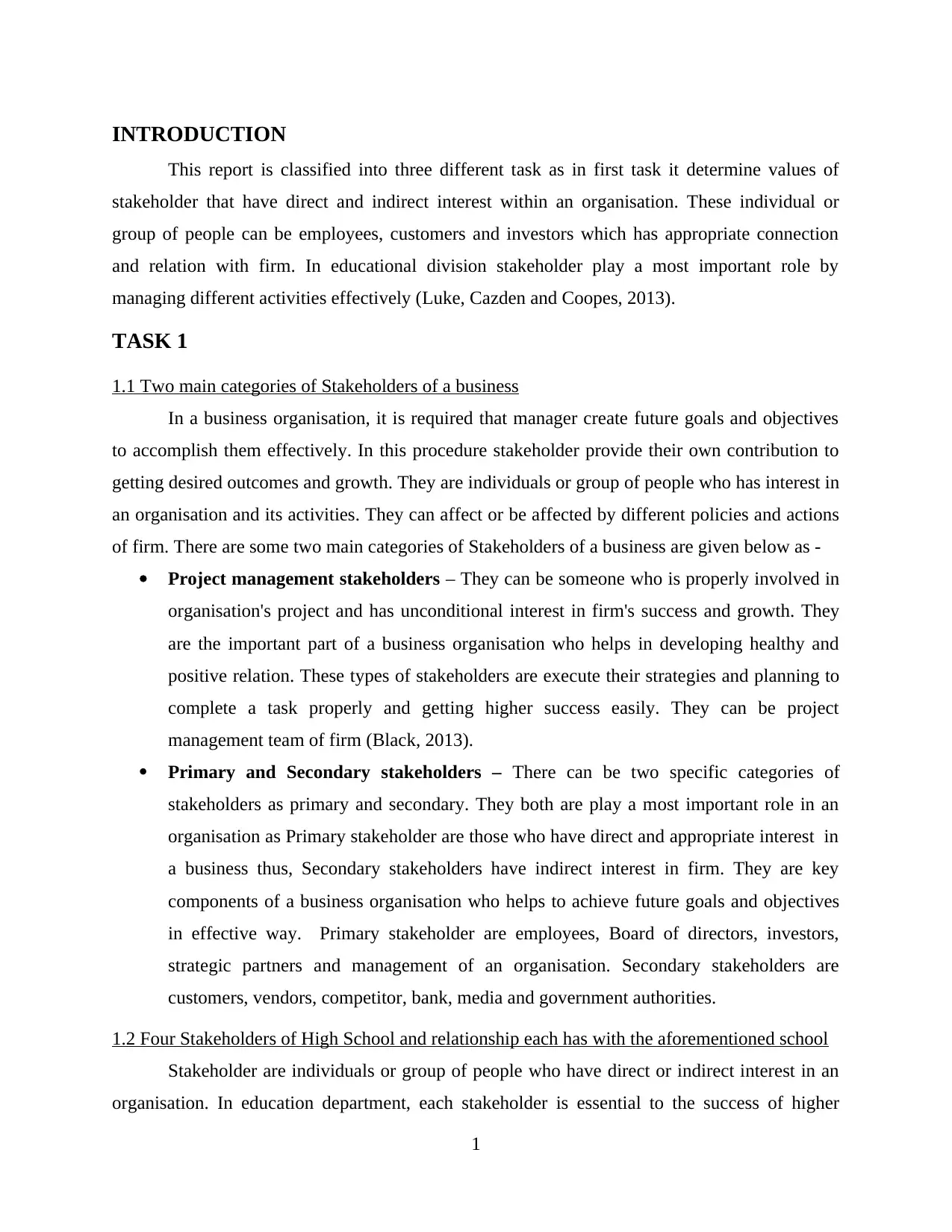
INTRODUCTION
This report is classified into three different task as in first task it determine values of
stakeholder that have direct and indirect interest within an organisation. These individual or
group of people can be employees, customers and investors which has appropriate connection
and relation with firm. In educational division stakeholder play a most important role by
managing different activities effectively (Luke, Cazden and Coopes, 2013).
TASK 1
1.1 Two main categories of Stakeholders of a business
In a business organisation, it is required that manager create future goals and objectives
to accomplish them effectively. In this procedure stakeholder provide their own contribution to
getting desired outcomes and growth. They are individuals or group of people who has interest in
an organisation and its activities. They can affect or be affected by different policies and actions
of firm. There are some two main categories of Stakeholders of a business are given below as -
Project management stakeholders – They can be someone who is properly involved in
organisation's project and has unconditional interest in firm's success and growth. They
are the important part of a business organisation who helps in developing healthy and
positive relation. These types of stakeholders are execute their strategies and planning to
complete a task properly and getting higher success easily. They can be project
management team of firm (Black, 2013).
Primary and Secondary stakeholders – There can be two specific categories of
stakeholders as primary and secondary. They both are play a most important role in an
organisation as Primary stakeholder are those who have direct and appropriate interest in
a business thus, Secondary stakeholders have indirect interest in firm. They are key
components of a business organisation who helps to achieve future goals and objectives
in effective way. Primary stakeholder are employees, Board of directors, investors,
strategic partners and management of an organisation. Secondary stakeholders are
customers, vendors, competitor, bank, media and government authorities.
1.2 Four Stakeholders of High School and relationship each has with the aforementioned school
Stakeholder are individuals or group of people who have direct or indirect interest in an
organisation. In education department, each stakeholder is essential to the success of higher
1
This report is classified into three different task as in first task it determine values of
stakeholder that have direct and indirect interest within an organisation. These individual or
group of people can be employees, customers and investors which has appropriate connection
and relation with firm. In educational division stakeholder play a most important role by
managing different activities effectively (Luke, Cazden and Coopes, 2013).
TASK 1
1.1 Two main categories of Stakeholders of a business
In a business organisation, it is required that manager create future goals and objectives
to accomplish them effectively. In this procedure stakeholder provide their own contribution to
getting desired outcomes and growth. They are individuals or group of people who has interest in
an organisation and its activities. They can affect or be affected by different policies and actions
of firm. There are some two main categories of Stakeholders of a business are given below as -
Project management stakeholders – They can be someone who is properly involved in
organisation's project and has unconditional interest in firm's success and growth. They
are the important part of a business organisation who helps in developing healthy and
positive relation. These types of stakeholders are execute their strategies and planning to
complete a task properly and getting higher success easily. They can be project
management team of firm (Black, 2013).
Primary and Secondary stakeholders – There can be two specific categories of
stakeholders as primary and secondary. They both are play a most important role in an
organisation as Primary stakeholder are those who have direct and appropriate interest in
a business thus, Secondary stakeholders have indirect interest in firm. They are key
components of a business organisation who helps to achieve future goals and objectives
in effective way. Primary stakeholder are employees, Board of directors, investors,
strategic partners and management of an organisation. Secondary stakeholders are
customers, vendors, competitor, bank, media and government authorities.
1.2 Four Stakeholders of High School and relationship each has with the aforementioned school
Stakeholder are individuals or group of people who have direct or indirect interest in an
organisation. In education department, each stakeholder is essential to the success of higher
1
⊘ This is a preview!⊘
Do you want full access?
Subscribe today to unlock all pages.

Trusted by 1+ million students worldwide
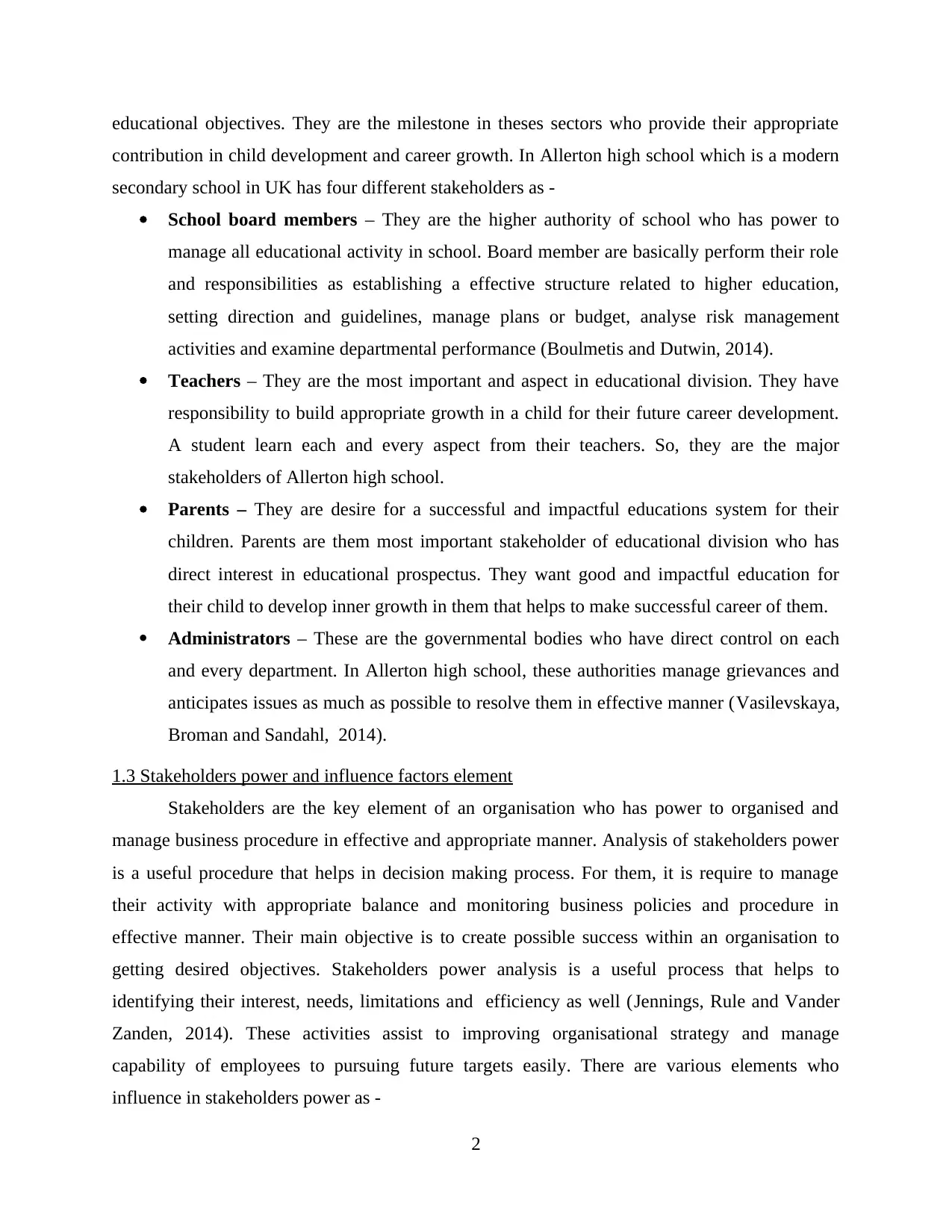
educational objectives. They are the milestone in theses sectors who provide their appropriate
contribution in child development and career growth. In Allerton high school which is a modern
secondary school in UK has four different stakeholders as -
School board members – They are the higher authority of school who has power to
manage all educational activity in school. Board member are basically perform their role
and responsibilities as establishing a effective structure related to higher education,
setting direction and guidelines, manage plans or budget, analyse risk management
activities and examine departmental performance (Boulmetis and Dutwin, 2014).
Teachers – They are the most important and aspect in educational division. They have
responsibility to build appropriate growth in a child for their future career development.
A student learn each and every aspect from their teachers. So, they are the major
stakeholders of Allerton high school.
Parents – They are desire for a successful and impactful educations system for their
children. Parents are them most important stakeholder of educational division who has
direct interest in educational prospectus. They want good and impactful education for
their child to develop inner growth in them that helps to make successful career of them.
Administrators – These are the governmental bodies who have direct control on each
and every department. In Allerton high school, these authorities manage grievances and
anticipates issues as much as possible to resolve them in effective manner (Vasilevskaya,
Broman and Sandahl, 2014).
1.3 Stakeholders power and influence factors element
Stakeholders are the key element of an organisation who has power to organised and
manage business procedure in effective and appropriate manner. Analysis of stakeholders power
is a useful procedure that helps in decision making process. For them, it is require to manage
their activity with appropriate balance and monitoring business policies and procedure in
effective manner. Their main objective is to create possible success within an organisation to
getting desired objectives. Stakeholders power analysis is a useful process that helps to
identifying their interest, needs, limitations and efficiency as well (Jennings, Rule and Vander
Zanden, 2014). These activities assist to improving organisational strategy and manage
capability of employees to pursuing future targets easily. There are various elements who
influence in stakeholders power as -
2
contribution in child development and career growth. In Allerton high school which is a modern
secondary school in UK has four different stakeholders as -
School board members – They are the higher authority of school who has power to
manage all educational activity in school. Board member are basically perform their role
and responsibilities as establishing a effective structure related to higher education,
setting direction and guidelines, manage plans or budget, analyse risk management
activities and examine departmental performance (Boulmetis and Dutwin, 2014).
Teachers – They are the most important and aspect in educational division. They have
responsibility to build appropriate growth in a child for their future career development.
A student learn each and every aspect from their teachers. So, they are the major
stakeholders of Allerton high school.
Parents – They are desire for a successful and impactful educations system for their
children. Parents are them most important stakeholder of educational division who has
direct interest in educational prospectus. They want good and impactful education for
their child to develop inner growth in them that helps to make successful career of them.
Administrators – These are the governmental bodies who have direct control on each
and every department. In Allerton high school, these authorities manage grievances and
anticipates issues as much as possible to resolve them in effective manner (Vasilevskaya,
Broman and Sandahl, 2014).
1.3 Stakeholders power and influence factors element
Stakeholders are the key element of an organisation who has power to organised and
manage business procedure in effective and appropriate manner. Analysis of stakeholders power
is a useful procedure that helps in decision making process. For them, it is require to manage
their activity with appropriate balance and monitoring business policies and procedure in
effective manner. Their main objective is to create possible success within an organisation to
getting desired objectives. Stakeholders power analysis is a useful process that helps to
identifying their interest, needs, limitations and efficiency as well (Jennings, Rule and Vander
Zanden, 2014). These activities assist to improving organisational strategy and manage
capability of employees to pursuing future targets easily. There are various elements who
influence in stakeholders power as -
2
Paraphrase This Document
Need a fresh take? Get an instant paraphrase of this document with our AI Paraphraser
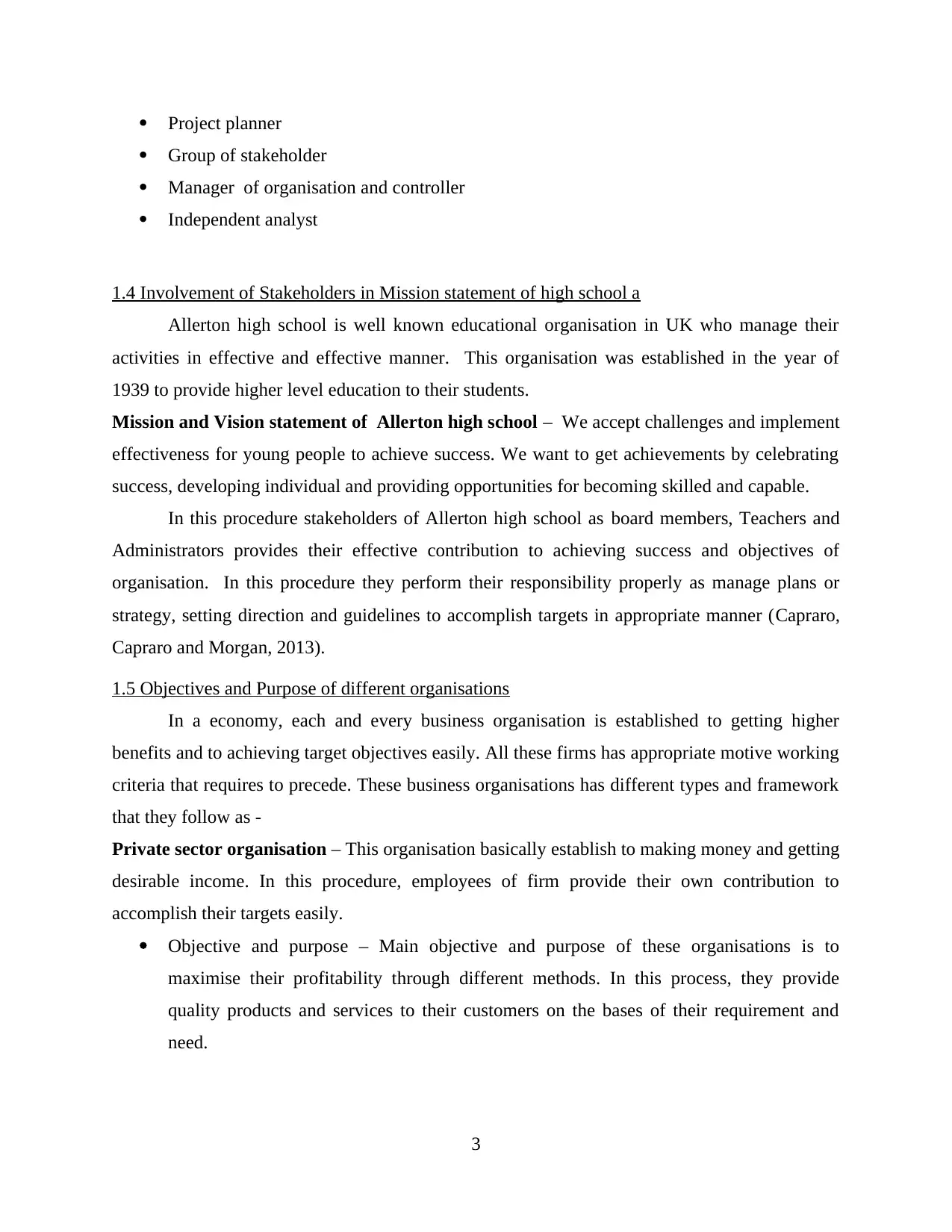
Project planner
Group of stakeholder
Manager of organisation and controller
Independent analyst
1.4 Involvement of Stakeholders in Mission statement of high school a
Allerton high school is well known educational organisation in UK who manage their
activities in effective and effective manner. This organisation was established in the year of
1939 to provide higher level education to their students.
Mission and Vision statement of Allerton high school – We accept challenges and implement
effectiveness for young people to achieve success. We want to get achievements by celebrating
success, developing individual and providing opportunities for becoming skilled and capable.
In this procedure stakeholders of Allerton high school as board members, Teachers and
Administrators provides their effective contribution to achieving success and objectives of
organisation. In this procedure they perform their responsibility properly as manage plans or
strategy, setting direction and guidelines to accomplish targets in appropriate manner (Capraro,
Capraro and Morgan, 2013).
1.5 Objectives and Purpose of different organisations
In a economy, each and every business organisation is established to getting higher
benefits and to achieving target objectives easily. All these firms has appropriate motive working
criteria that requires to precede. These business organisations has different types and framework
that they follow as -
Private sector organisation – This organisation basically establish to making money and getting
desirable income. In this procedure, employees of firm provide their own contribution to
accomplish their targets easily.
Objective and purpose – Main objective and purpose of these organisations is to
maximise their profitability through different methods. In this process, they provide
quality products and services to their customers on the bases of their requirement and
need.
3
Group of stakeholder
Manager of organisation and controller
Independent analyst
1.4 Involvement of Stakeholders in Mission statement of high school a
Allerton high school is well known educational organisation in UK who manage their
activities in effective and effective manner. This organisation was established in the year of
1939 to provide higher level education to their students.
Mission and Vision statement of Allerton high school – We accept challenges and implement
effectiveness for young people to achieve success. We want to get achievements by celebrating
success, developing individual and providing opportunities for becoming skilled and capable.
In this procedure stakeholders of Allerton high school as board members, Teachers and
Administrators provides their effective contribution to achieving success and objectives of
organisation. In this procedure they perform their responsibility properly as manage plans or
strategy, setting direction and guidelines to accomplish targets in appropriate manner (Capraro,
Capraro and Morgan, 2013).
1.5 Objectives and Purpose of different organisations
In a economy, each and every business organisation is established to getting higher
benefits and to achieving target objectives easily. All these firms has appropriate motive working
criteria that requires to precede. These business organisations has different types and framework
that they follow as -
Private sector organisation – This organisation basically establish to making money and getting
desirable income. In this procedure, employees of firm provide their own contribution to
accomplish their targets easily.
Objective and purpose – Main objective and purpose of these organisations is to
maximise their profitability through different methods. In this process, they provide
quality products and services to their customers on the bases of their requirement and
need.
3
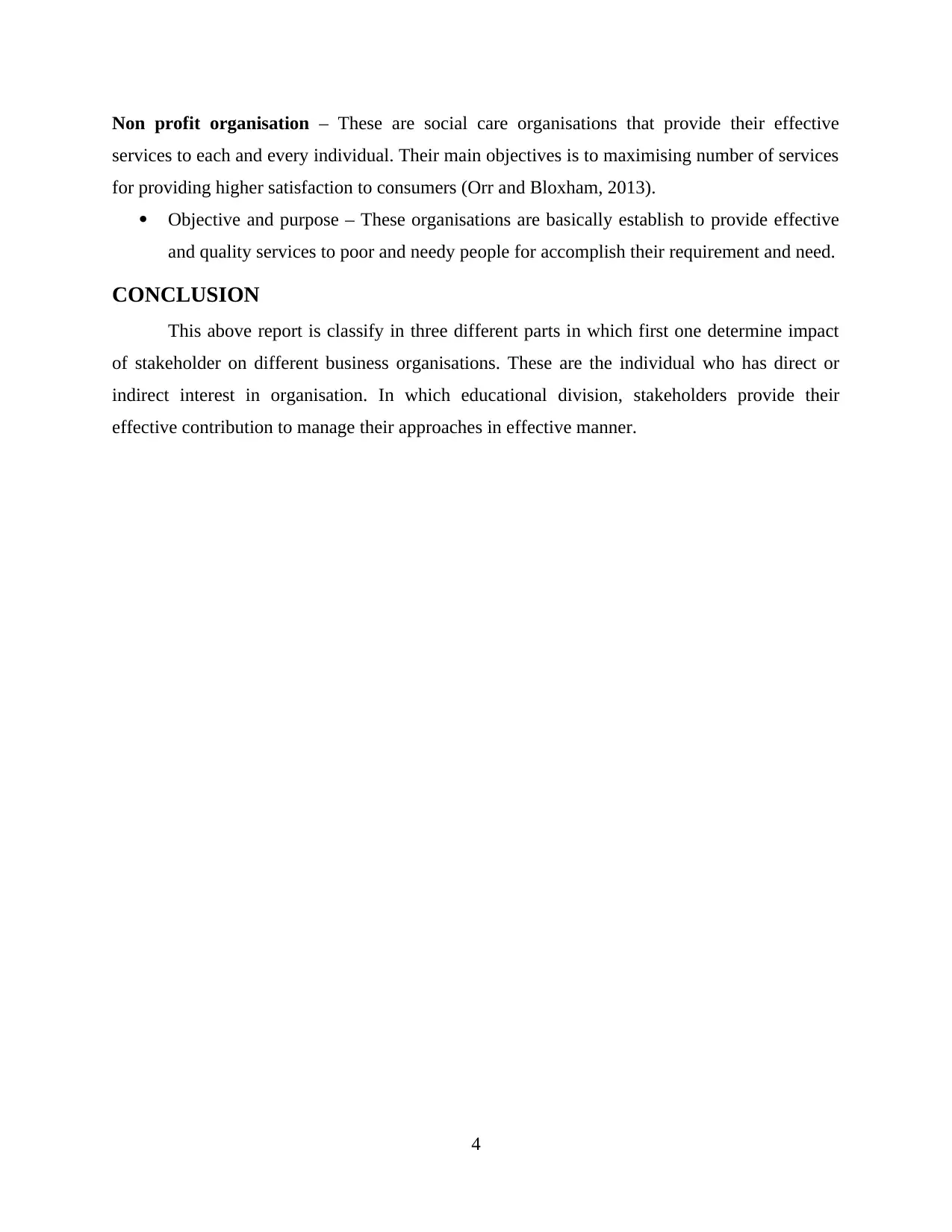
Non profit organisation – These are social care organisations that provide their effective
services to each and every individual. Their main objectives is to maximising number of services
for providing higher satisfaction to consumers (Orr and Bloxham, 2013).
Objective and purpose – These organisations are basically establish to provide effective
and quality services to poor and needy people for accomplish their requirement and need.
CONCLUSION
This above report is classify in three different parts in which first one determine impact
of stakeholder on different business organisations. These are the individual who has direct or
indirect interest in organisation. In which educational division, stakeholders provide their
effective contribution to manage their approaches in effective manner.
4
services to each and every individual. Their main objectives is to maximising number of services
for providing higher satisfaction to consumers (Orr and Bloxham, 2013).
Objective and purpose – These organisations are basically establish to provide effective
and quality services to poor and needy people for accomplish their requirement and need.
CONCLUSION
This above report is classify in three different parts in which first one determine impact
of stakeholder on different business organisations. These are the individual who has direct or
indirect interest in organisation. In which educational division, stakeholders provide their
effective contribution to manage their approaches in effective manner.
4
⊘ This is a preview!⊘
Do you want full access?
Subscribe today to unlock all pages.

Trusted by 1+ million students worldwide
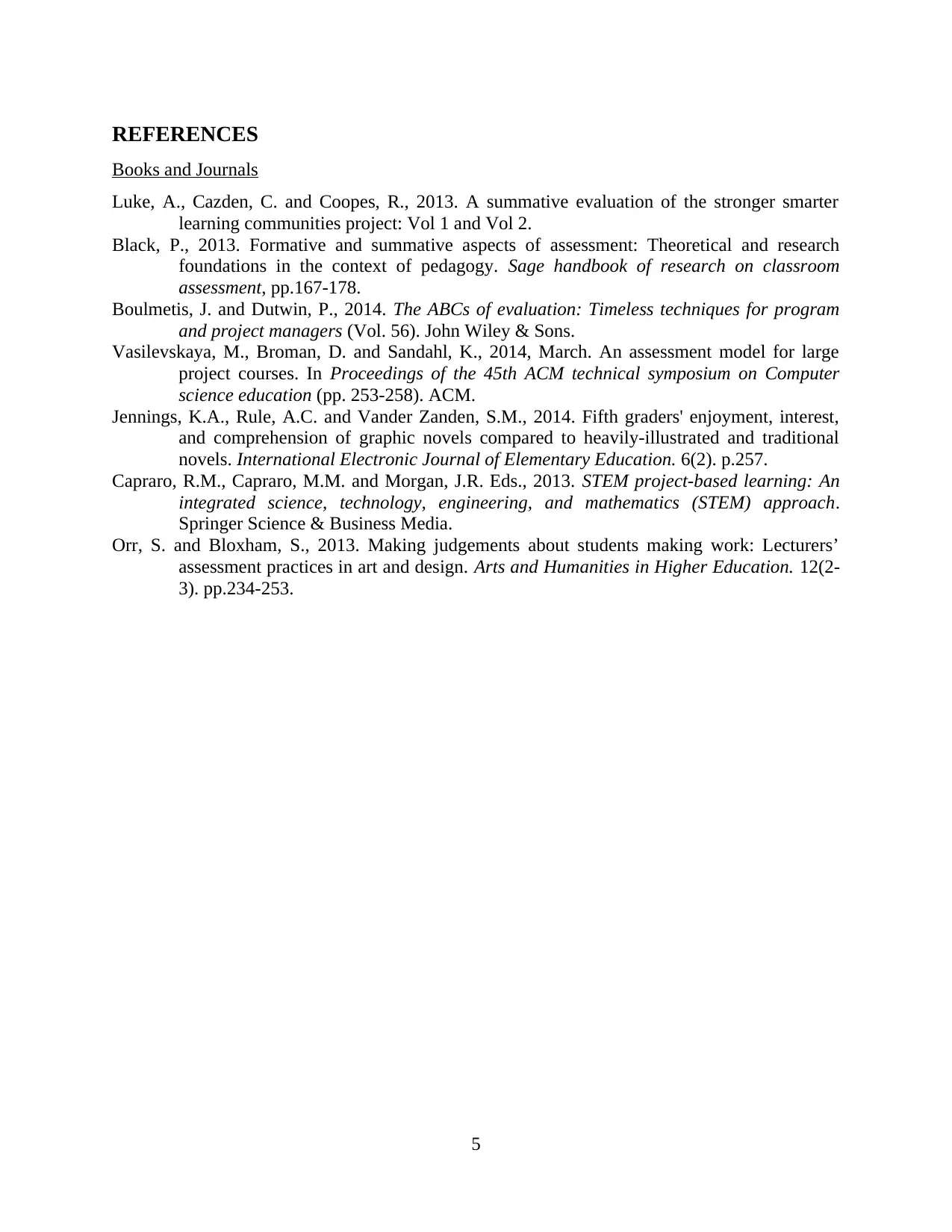
REFERENCES
Books and Journals
Luke, A., Cazden, C. and Coopes, R., 2013. A summative evaluation of the stronger smarter
learning communities project: Vol 1 and Vol 2.
Black, P., 2013. Formative and summative aspects of assessment: Theoretical and research
foundations in the context of pedagogy. Sage handbook of research on classroom
assessment, pp.167-178.
Boulmetis, J. and Dutwin, P., 2014. The ABCs of evaluation: Timeless techniques for program
and project managers (Vol. 56). John Wiley & Sons.
Vasilevskaya, M., Broman, D. and Sandahl, K., 2014, March. An assessment model for large
project courses. In Proceedings of the 45th ACM technical symposium on Computer
science education (pp. 253-258). ACM.
Jennings, K.A., Rule, A.C. and Vander Zanden, S.M., 2014. Fifth graders' enjoyment, interest,
and comprehension of graphic novels compared to heavily-illustrated and traditional
novels. International Electronic Journal of Elementary Education. 6(2). p.257.
Capraro, R.M., Capraro, M.M. and Morgan, J.R. Eds., 2013. STEM project-based learning: An
integrated science, technology, engineering, and mathematics (STEM) approach.
Springer Science & Business Media.
Orr, S. and Bloxham, S., 2013. Making judgements about students making work: Lecturers’
assessment practices in art and design. Arts and Humanities in Higher Education. 12(2-
3). pp.234-253.
5
Books and Journals
Luke, A., Cazden, C. and Coopes, R., 2013. A summative evaluation of the stronger smarter
learning communities project: Vol 1 and Vol 2.
Black, P., 2013. Formative and summative aspects of assessment: Theoretical and research
foundations in the context of pedagogy. Sage handbook of research on classroom
assessment, pp.167-178.
Boulmetis, J. and Dutwin, P., 2014. The ABCs of evaluation: Timeless techniques for program
and project managers (Vol. 56). John Wiley & Sons.
Vasilevskaya, M., Broman, D. and Sandahl, K., 2014, March. An assessment model for large
project courses. In Proceedings of the 45th ACM technical symposium on Computer
science education (pp. 253-258). ACM.
Jennings, K.A., Rule, A.C. and Vander Zanden, S.M., 2014. Fifth graders' enjoyment, interest,
and comprehension of graphic novels compared to heavily-illustrated and traditional
novels. International Electronic Journal of Elementary Education. 6(2). p.257.
Capraro, R.M., Capraro, M.M. and Morgan, J.R. Eds., 2013. STEM project-based learning: An
integrated science, technology, engineering, and mathematics (STEM) approach.
Springer Science & Business Media.
Orr, S. and Bloxham, S., 2013. Making judgements about students making work: Lecturers’
assessment practices in art and design. Arts and Humanities in Higher Education. 12(2-
3). pp.234-253.
5
1 out of 7
Related Documents
Your All-in-One AI-Powered Toolkit for Academic Success.
+13062052269
info@desklib.com
Available 24*7 on WhatsApp / Email
![[object Object]](/_next/static/media/star-bottom.7253800d.svg)
Unlock your academic potential
Copyright © 2020–2025 A2Z Services. All Rights Reserved. Developed and managed by ZUCOL.





